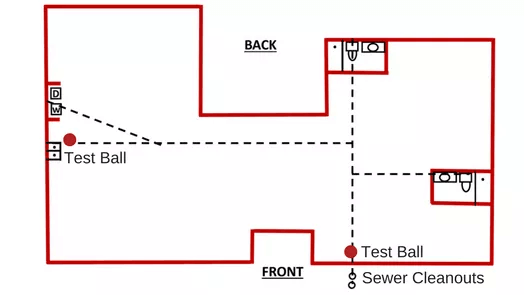
In our last post, we explained how we test your home’s sewer lines to determine if you have a leak or leaks in your sewer system.
But how do we find out how many leaks you have and where they are? With a sewer leak isolation test.
Sidenote: If a plumber uses a sewer camera to determine you have leaks and/or to locate them, read this post to find out why that’s a bad thing.
What Is a Sewer Leak Isolation Test?
Rubber, inflatable test balls of various sizes attached to air hoses are strategically placed in the sewer pipes under your home. The test balls create artificial stoppages enabling us to isolate certain portions of the pipe.

We then fill each section with water and watch for a drop in water level from an observation point.
This is when a sewer camera is useful in sewer leak detection. We use the camera to place the test balls where they need to be. We also use them for finding the test balls in the line.
Sewer Leak Isolation Test Steps
Now let’s walk through the steps we take for finding the leaks.

Diagram 1
This is a bird’s eye view of our example home. And for the purpose of this example test, let’s assume there are two leaks, one at the kitchen sink area and one at the front bathroom area.
First, we will test the section of pipe leading to the back bathroom. We place a test ball in a spot that isolates that part of the pipe and fill that section with water. Once the water is at slab level, we watch at the observation point for a drop in water level.

Diagram 2
In our example, there is no leak in that section of the pipe there will be no change in water level. Therefore we know there is no leak. Next we move the test ball and fill the isolated pipes with water to start another test.

Diagram 3
With the test ball inflated at the location in the above diagram, we run the water again to fill the pipes running to the back bathroom, the kitchen, and the washer/dryer line.
Since we know there is no leak in the pipe running to the back bathroom, if we see a drop in water level, we know there is a leak or leaks in one of the lines leading to the kitchen or the washer/dryer lines.
Now we need to determine where the leak is, the kitchen or the W/D. Now we leave the first test ball where it is and place another one at the kitchen sink.

Diagram 4
The leak at the kitchen sink is blocked off by the second test ball and the lines are still mostly filled with water. We now fill it back up until it reaches the observation point level and watch again for a drop.
In this example, there is no drop so we know the leak is at the kitchen sink. The remaining line has no leaks.
Now we move the original test ball (Diagram 1) to the edge of the house. We fill the entire system again with the kitchen sink leak blocked, to see if there are any other leaks.

Diagram 5
Once the lines are filled and we see a drop in water level, we know thanks to the process of elimination the leak is either in the line leading to the front bathroom or the section of pipe from the edge of the house to where we placed the test ball in the second test.
We leave the test ball at the kitchen sink and at the edge of the house and then place another test ball at the front bathroom.

Diagram 6
We add water to bring the level back up to the observation point and see there is no drop. From this we can conclude there is a second leak at the front bathroom.
For a video explanation of the this same example, check out our YouTube channel:
Every Case Is Different
Now this is just one example of how we would perform a leak isolation test.
Keep in mind, because every house is different and every case is different, every test is different. For example, the observation points could be the floor flange under a toilet, a kitchen sink, or a bathtub.
Also we don’t guarantee there are no other leaks until we do the repairs and perform another under slab sewer leak test.
There are a number of reasons for this.
It’s always possible another leak occurred between the time we did the isolation test and the repair.
It’s also possible that there was a very, very slow leak when we performed the leak location test but the dirt around your pipes was oversaturated at the time and didn’t allow water to escape.
Or, take our example house, say there’s a leak at the kitchen sink, the W/D, and both bathrooms. Because we have to use test balls to block every slab level observation point, it is impossible to test the rest of the sewer lines. So we would have to repair those leaks first and then retest for leaks in the rest of the system.
Our goal at In-House Plumbing is to find every leak. Some companies come in, find one leak, repair it and leave without testing for more leaks. Check out our guide on how to find a reliable plumbing company to help you.
If you’ve had a plumber come out and use a sewer camera to determine if you have any sewer leaks and to locate those leaks, give us a call for a free second opinion.
Or if you have any questions, comments or concerns, post them below. Or call our office at 972-494-1750.

